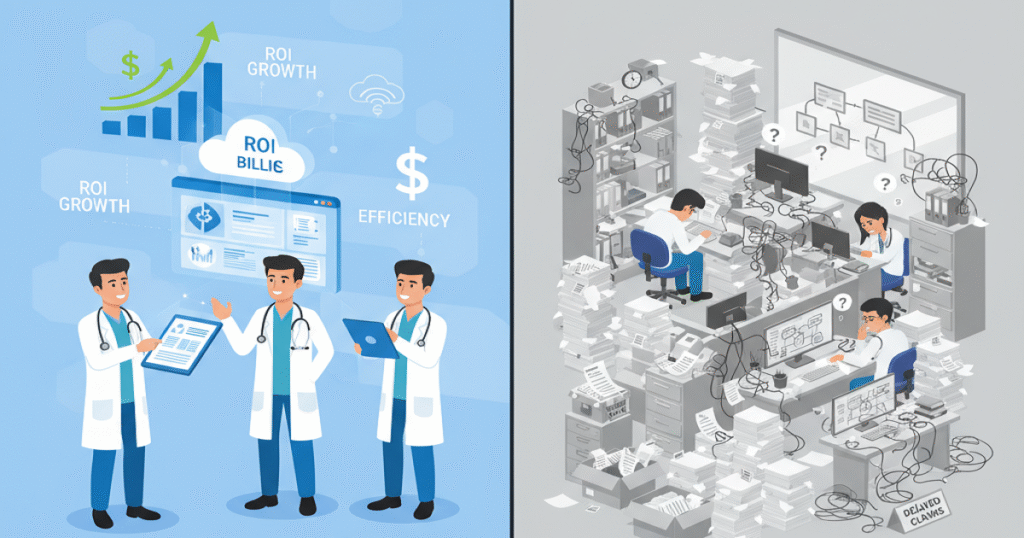From Chart to Claim: Practical Ways to Use AI Coding in Your Practice by 2026
Medical BillingTelehealth changed how providers deliver care. Now, AI is doing the same thing for coding and revenue cycle management. It’s not hype anymore. Practices across the country are already using AI to clean up documentation, spot missing billable services, suggest codes, and catch errors before claims go out the door. And by 2026, AI coding won’t just be a “nice to have”, but it’ll be a standard part of how practices keep claims clean and cash flow steady. If you’ve been wondering what the future of RCM technology looks like or what AI coding can realistically do inside a busy practice, this breakdown will help you understand the real use cases, the models that actually work, and the steps you can take over the next year to get ready. AI Coding Today: What It Actually Does AI coding has grown fast. It’s no longer a rough “auto-suggest” tool that picks random codes and hopes for the best. Most tools now use natural language processing to read a clinician’s note, almost like a trained coder would. They pick up diagnoses, procedures, orders, symptoms, and treatments, then suggest ICD-10, CPT, and HCPCS codes based on that content. And instead of working separately, these systems run inside the EHR or right next to it. So as providers document the visit, they’re already seeing what the AI thinks the final code set should look like. Some systems function as computer-assisted coding (CAC), while others act almost like autonomous engines for high-volume encounters such as routine outpatient visits. The key point? These tools aren’t meant to replace coders. Practices that use them well report faster coding, fewer errors, and fewer denials, but only when humans stay involved. AI speeds up the routine parts and flags missing details, but humans make the judgment calls. Where AI Fits in the Workflow: From Chart to Claim The best way to understand AI’s value is to look at how it behaves during a real visit. When a provider finishes their note, the AI reviews the documentation and pre-codes the encounter. Before the note is even signed, it can warn the provider if important details are missing. Details that would normally cause denials later. For example, it might flag a missing laterality, a vague diagnosis, or an ambiguous procedure that needs clarification. AI is especially helpful when it comes to preventing under-coding. Many providers unintentionally leave money on the table by documenting thoroughly but coding too conservatively. AI spots visits where the documentation supports a higher level of service or additional billable items that weren’t captured. The other big gain is error-proofing. AI checks the documentation and suggested codes against payer rules. If a diagnosis doesn’t match the procedure, if a modifier is needed, or if two codes can’t be billed together under a specific payer’s bundling rules, the system calls it out early. Instead of discovering these issues after the claim is rejected, your team fixes them up front. Some tools go even further and help generate claims automatically, validate eligibility, and run a real-time rules engine so errors never make it downstream. When everything happens before the claim leaves the building, your clean-claim rate climbs and your denial rate drops. Why Hybrid Models Work Better Than Fully Autonomous Coding The practices seeing the best results in 2025–2026 aren’t pushing humans out of the process. They’re doing the opposite. They’re using AI to support coders, not replace them. In a hybrid model, AI does the heavy lifting: But before the claim is finalized, a certified coder or biller reviews everything and approves it. Humans still handle complex encounters, unusual procedures, and nuanced clinical judgment. They also catch subtleties the AI might miss, like coding choices tied to medical necessity, severity of illness, or specific payer quirks that aren’t well documented. When organizations skip this step and jump straight to fully autonomous coding, they often see temporary spikes in denials. Not because the AI is “wrong,” but because every specialty, payer mix, and workflow has its own quirks. Hybrid models let you tune the system safely and build governance before relying too heavily on automation. What a Typical Practice Can Realistically Achieve by 2026 This is where the future of RCM technology gets practical. You don’t need a massive budget or a full IT team to use AI in coding. A typical outpatient practice, specialty clinic, or multi-provider group can make meaningful improvements by integrating AI into the parts of the workflow that create the most rework today. By 2026, your practice can easily: Instead of relying on trial and error, you’ll use actual data to shape better workflows and reduce denials upstream. Compliance and Governance: The Part No One Can Skip As AI takes on more responsibility in RCM, oversight becomes more important, not less. Regulators and payers expect practices to show that coding decisions are explainable. That means you need clear audit trails showing where codes came from, how often the AI is reviewed, and when humans stepped in. Practices should also set simple rules: which encounters can be auto-coded, how often random samples are audited, when models are updated for code set changes, and what happens when AI and human coders disagree. Training is another key part of compliance. Providers and coders need to understand how to work with AI without blindly accepting or rejecting its suggestions. Human beings respond better when they know the reasoning behind the suggestions, which leads to higher accuracy and increased compliance. Final Thoughts AI coding isn’t the future, and it’s already here. And by 2026, practices that embrace it thoughtfully will run smoothly, face fewer denials, and spend less time correcting preventable mistakes. The goal isn’t to hand-code over to a black-box engine. It’s to blend AI speed with human judgment so your team can work faster, cleaner, and with far fewer headaches.
From Chart to Claim: Practical Ways to Use AI Coding in Your Practice by 2026 Read More »



















